There was a time when sandwiches weren’t just lunch—they were a reflection of regional pride, family tradition, and the flavors of an era. From brown bag school lunches to counter-service diners, these handheld meals defined decades of American eating. But over the years, many of them have slipped quietly out of rotation. Changing tastes, shifting health trends, and evolving convenience have pushed certain quirky classics into the background, where only the most nostalgic remember them.
Today’s sandwich scene is dominated by avocado toasts, paninis, and craft deli stacks, but there’s a whole generation of sandwiches that helped pave the way—each with its own unique story. Some were practical Depression-era creations born of pantry staples. Others were bold flavor experiments that somehow earned a loyal following. And a few were just plain fun, like peanut butter with pickles or a deep-fried Monte Cristo. While these sandwiches may not be trending today, they once had their moment in the spotlight.
In this list, we’re taking a fond look back at 16 sandwiches we rarely see anymore, whether they’ve vanished from diners, disappeared from lunchboxes, or simply faded with time. But instead of dismissing them, we’re revisiting what made them special—and why they mattered. They represent more than outdated ingredients; they tell stories of past generations, regional flavor trends, and the ever-changing American palate.
And it’s not all about what we’ve lost. Alongside these forgotten bites, we’re shining a light on 8 retro favorites that still deserve a second chance. Some classics never truly go out of style—they just need a little rediscovery. So unwrap your memories and prepare to explore the delicious oddities, humble heroes, and hidden gems of sandwich history. One of them might just inspire your next bite.
1. Prune Butter Sandwich
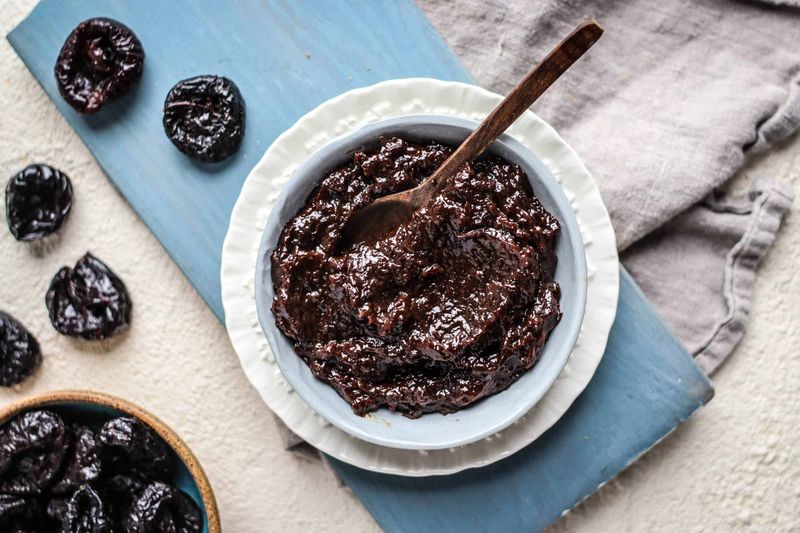
Born from necessity during the Great Depression, prune butter sandwiches were a thrifty solution when fresh fruit became a luxury. Stewed prunes mashed into a dark, sticky paste spread across day-old bread offered an affordable sweet treat for hungry families.
Children would often find these dense, intensely sweet sandwiches in their lunch pails, sometimes doctored with a sprinkle of cinnamon or a smear of butter to make them more palatable. While nutritious and filling, the mushy texture and overpowering sweetness made these sandwiches a frequent victim of playground trades.
2. Sardine and Onion Sandwich

Maritime workers and coastal families once embraced this pungent combination as a protein-packed lunch option. Oily sardines straight from the tin would be layered with razor-thin raw onion slices on thick-cut bread, creating a sandwich that announced itself from three tables away.
The fishy-sharp aroma cleared rooms and made seatmates on park benches hastily relocate. Despite its nutritional benefits, this sandwich’s overwhelming smell and taste gradually lost favor as more palatable options became available.
Grandparents might reminisce about these sandwiches with peculiar fondness, but few modern eaters would volunteer to revive this particularly aromatic lunch tradition.
3. Liverwurst and Onion Sandwich
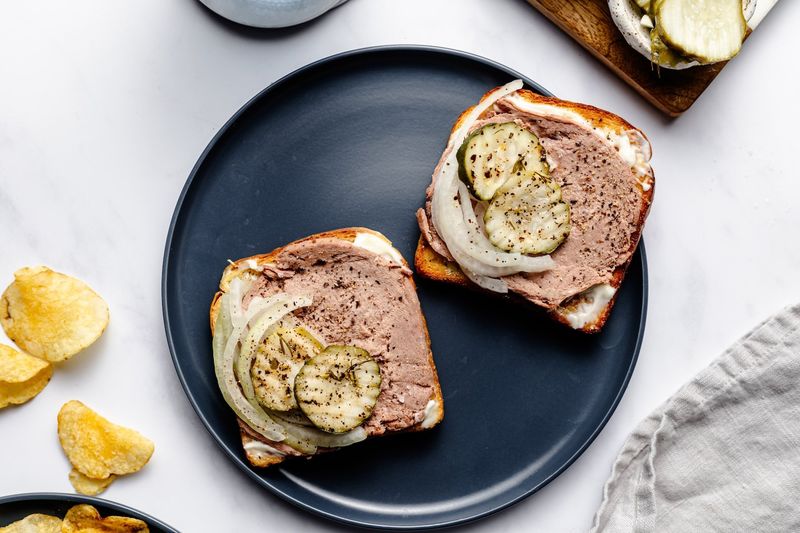
A staple in German-American households throughout the mid-20th century, this sandwich featured slices of spreadable liver sausage topped with sharp raw onions on rye bread. The pungent combination created a powerful sensory experience that divided families and started lunchroom disputes.
Liverwurst’s smooth, rich texture paired with the eye-watering bite of fresh onion made for a sandwich that was impossible to ignore. Often slathered with yellow mustard for extra kick, this creation demanded commitment from its eaters.
While some European delis still stock quality liverwurst, most Americans have gladly moved on from this particularly assertive sandwich option.
4. Beef Tongue Sandwich
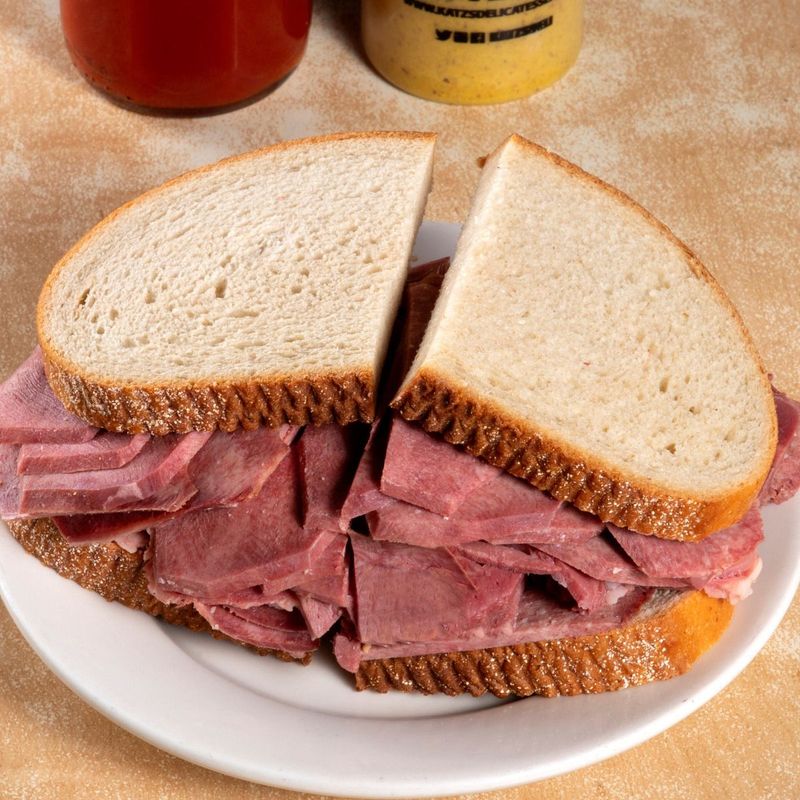
Once a crown jewel of Jewish delicatessens, beef tongue sandwiches featured thin-sliced, pink tongue meat stacked high between slices of rye bread. The meat’s velvety texture and rich flavor earned it a devoted following among adventurous eaters.
Preparation was a labor of love—tongues required hours of simmering before peeling away the tough outer layer to reveal the tender meat beneath. A generous schmear of spicy brown mustard cut through the richness, while some delis added a layer of coleslaw for crunch.
Modern diners’ squeamishness about eating recognizable animal parts gradually pushed this sandwich to the culinary margins.
5. Olive Nut Spread Sandwich
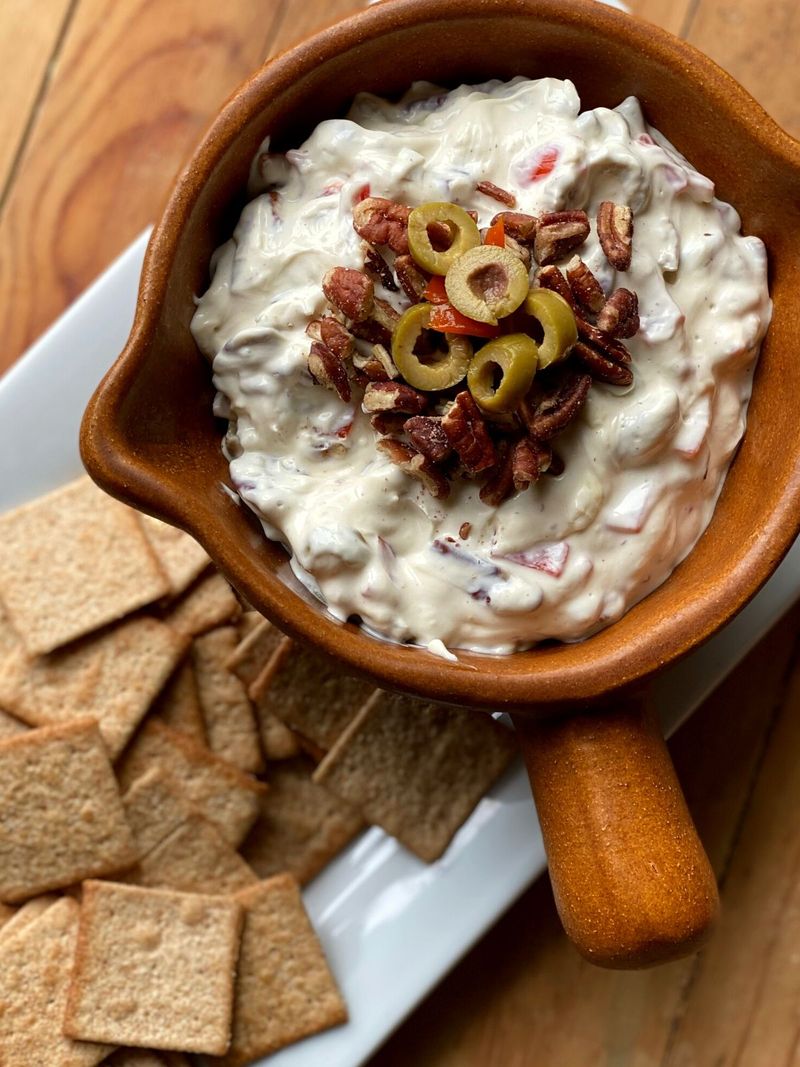
Southern garden parties and ladies’ luncheons once showcased these delicate tea sandwiches filled with a curious mixture of chopped green olives, walnuts, and cream cheese. The spread’s briny-creamy flavor profile created a sophisticated bite that somehow became a mid-century staple.
Crusts were meticulously removed before the sandwiches were cut into dainty triangles or fingers. The pale green filling peeked out enticingly between soft white bread slices, promising a salty-rich experience.
While occasionally resurrected for retro-themed gatherings, this labor-intensive sandwich spread has largely disappeared from regular rotation, its unique flavor combination too peculiar for modern palates.
6. Chow Mein Sandwich
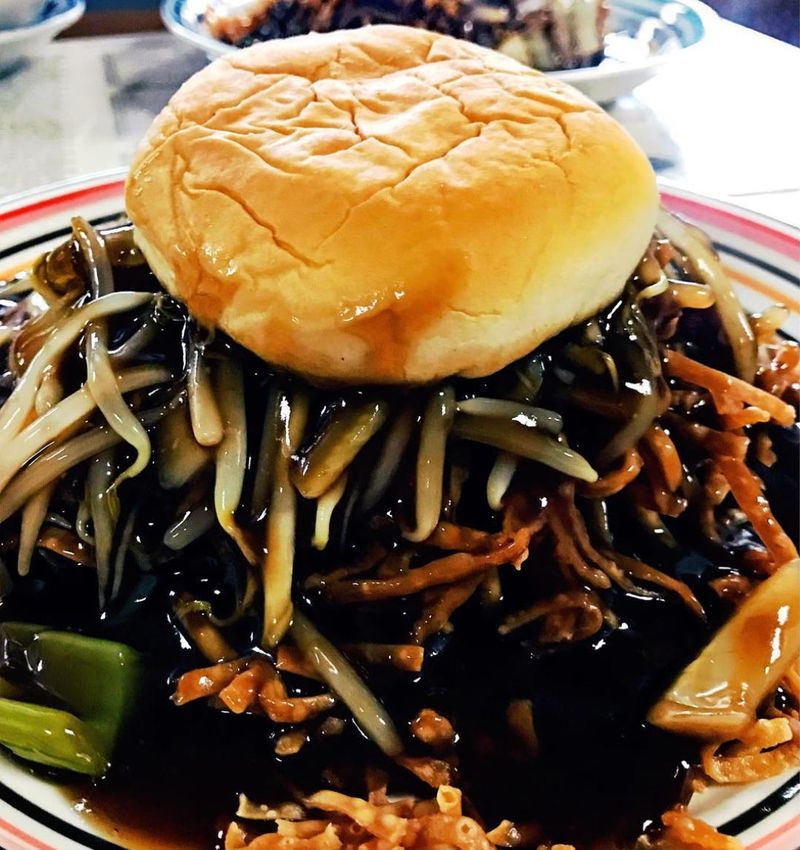
A bizarre regional specialty from Fall River, Massachusetts, the chow mein sandwich stuffed crispy noodles and brown gravy between hamburger buns. This cultural oddity represented early Chinese-American fusion before anyone called it that.
Local diners served these messy creations on paper plates with extra napkins. The contrasting textures—soft bun, crunchy noodles, and thick gravy—created an eating experience that was uniquely satisfying if somewhat structurally unsound.
Though it enjoyed cult status among New Englanders for decades, this sandwich’s peculiar combination of Eastern flavors and Western delivery system never gained national traction, remaining a curious footnote in American sandwich history.
7. Spam and Pickle Sandwich
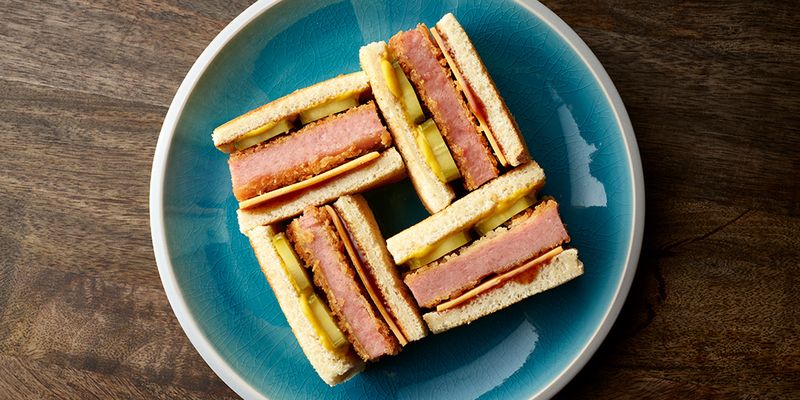
During wartime rationing, resourceful homemakers transformed canned meat into family meals. The Spam and pickle sandwich paired thin-sliced, pan-fried Spam with tart pickle rounds, creating a salty-tangy combination that stretched precious protein resources.
Kids from the 1940s and 50s often found these sandwiches in their metal lunch boxes, sometimes dressed with a smear of mayonnaise or yellow mustard. The pink processed meat developed a crispy exterior when fried, contrasting pleasantly with the crunchy pickle slices.
While Spam enjoys occasional culinary revivals, this particular sandwich combination has mercifully faded from American lunch counters.
8. Peanut Butter and Bacon Sandwich
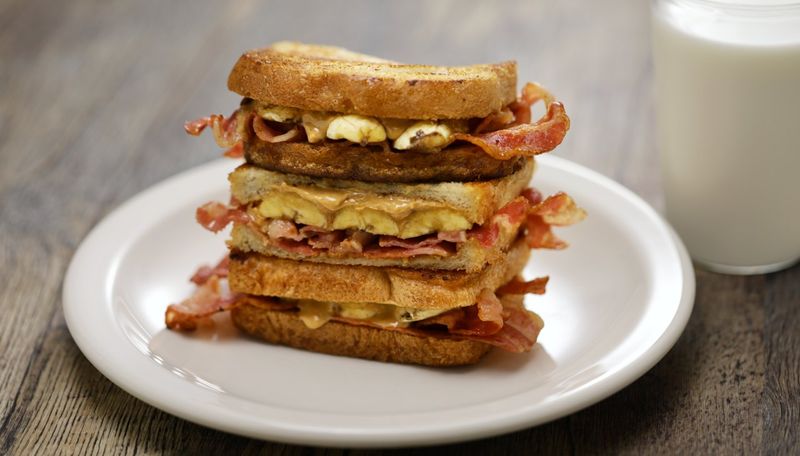
Elvis Presley may have famously enjoyed fried peanut butter and banana sandwiches, but the peanut butter and bacon variant had its own dedicated following. Crispy, salty bacon strips nestled into a thick layer of creamy peanut butter created a protein-packed combination that somehow worked despite itself.
Lunch counters across America served this unlikely pairing during the 1950s, often on white toast still warm enough to make the peanut butter slightly melty. The sandwich delivered a powerful umami punch that satisfied hearty appetites.
Health concerns eventually pushed this indulgent creation out of favor, though adventurous eaters occasionally resurrect it as a guilty pleasure.
9. Cream Cheese and Date Sandwich
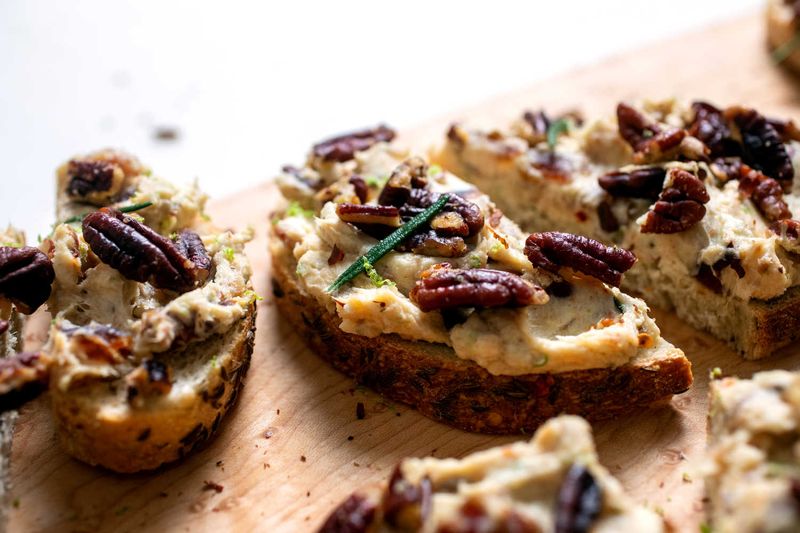
Sweet-toothed Americans once embraced this dessert-like sandwich that paired sticky chopped dates with cool cream cheese. Popular at bridge clubs and afternoon teas, this creation blurred the line between sandwich and confection.
The dates were often soaked briefly to soften them before being mixed with nuts and sometimes a touch of orange zest for brightness. Spread between slices of thinly-sliced white bread, the filling created a chewy-creamy contrast that paired perfectly with afternoon coffee.
As processed sweets became more available and dietary habits changed, this labor-intensive treat gradually disappeared from American tables.
10. Cucumber and Butter Sandwich
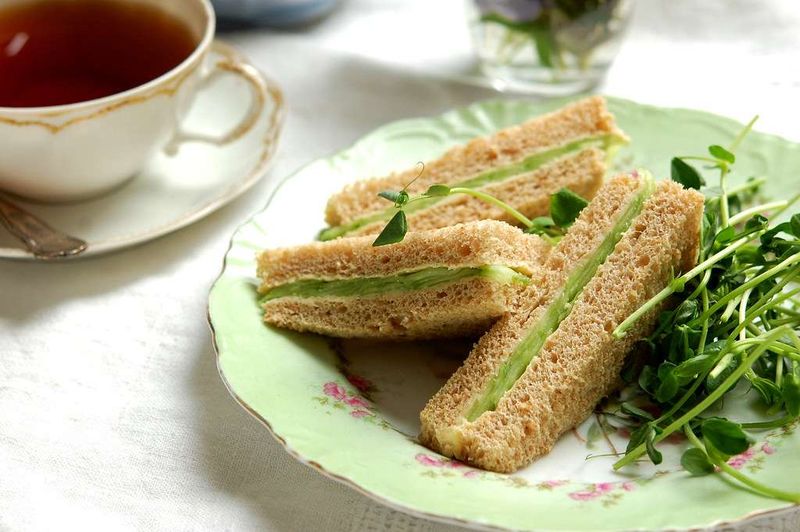
Borrowed from British afternoon tea traditions, cucumber and butter sandwiches briefly found favor among Americans aspiring to elegant entertaining. Paper-thin cucumber slices were carefully arranged over a generous layer of salted butter on crustless white bread.
The key to these deceptively simple sandwiches was technique—cucumbers needed to be peeled, sliced whisper-thin, and sometimes salted and patted dry to prevent sogginess. When properly executed, they offered a refreshing crispness and subtle flavor.
Though occasionally spotted at garden parties or fancy hotel teas, these labor-intensive sandwiches proved too delicate and understated for America’s bold flavor preferences.
11. Deviled Ham Spread Sandwich
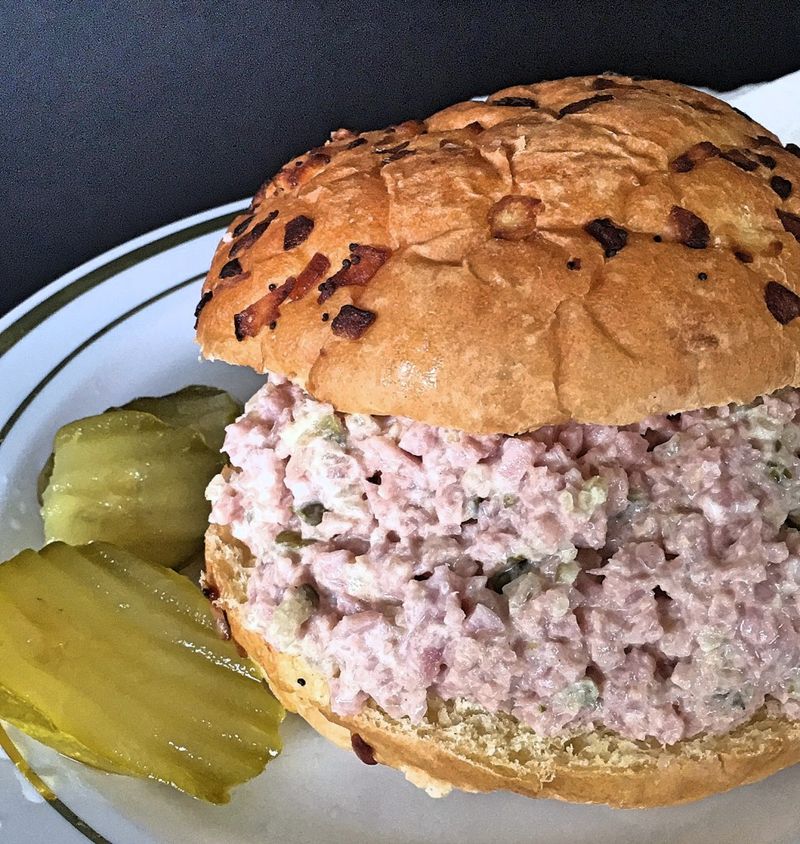
Underwood’s iconic devil-logoed cans contained a spiced ham spread that defined quick lunches for generations of American children. This pink, paste-like mixture spread easily on soft white bread, creating a sandwich that required minimal effort from busy parents.
The spread combined finely ground ham with mayonnaise, mustard, and various spices for a tangy, savory flavor. Some home cooks doctored the commercial version with chopped pickles, onions, or a dash of hot sauce.
While convenient, these sandwiches fell from favor as concerns about processed meats grew and lunchbox options expanded beyond simple spreads.
12. Cheese and Chutney Sandwich

British influence brought this sweet-savory combination to American tables during the mid-twentieth century. Sharp cheddar cheese slices paired with fruity mango chutney created a sophisticated flavor profile that briefly captivated adventurous eaters.
The sandwich worked best on hearty brown bread or a rustic country loaf that could stand up to the bold flavors. Some variations included thinly sliced apples or a handful of watercress for added freshness and crunch.
Despite its appealing contrast of tangy cheese and sweet-spiced chutney, this sandwich never fully established itself in the American sandwich canon, remaining a niche option that gradually faded from menus.
13. Egg and Olive Sandwich
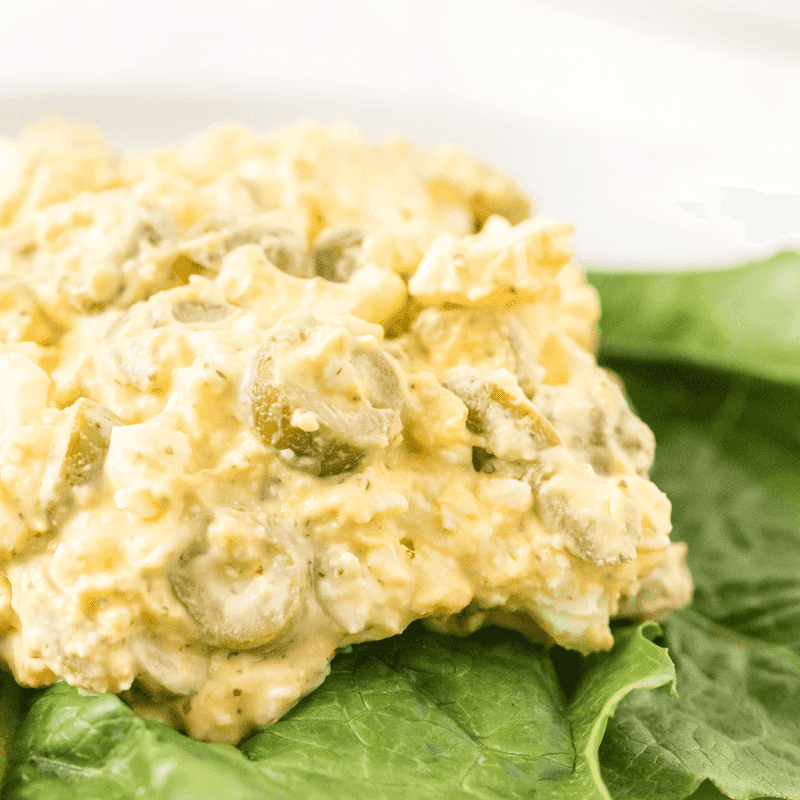
Midwestern church potlucks and family picnics often featured this curious spread combining chopped hard-boiled eggs with green olives and mayonnaise. The resulting pale yellow mixture studded with olive pieces created a uniquely textured sandwich filling that somehow became a regional staple.
Home cooks would carefully chop the eggs and olives by hand, sometimes adding celery for extra crunch or pimentos for color. The spread was typically served on soft white bread, though some preferred it on crackers as an appetizer.
While occasionally resurrected by nostalgic home cooks, this peculiar combination has largely disappeared from American tables, replaced by simpler egg salad variations.
14. Pickle and Peanut Butter Sandwich
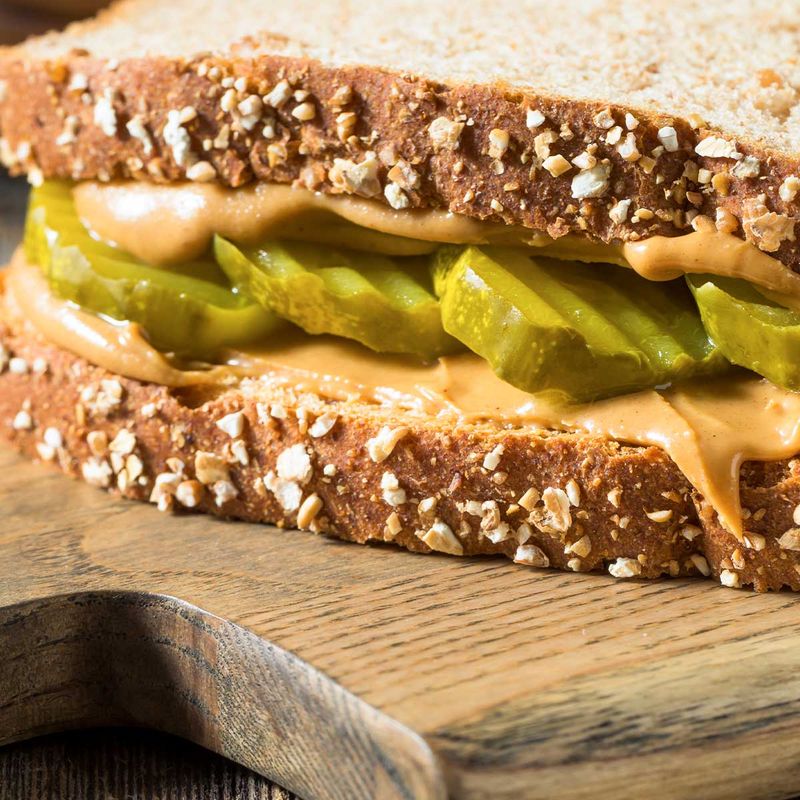
Pregnant women and curious children were the primary fans of this unusual combination that paired crunchy dill pickle slices with creamy peanut butter. The sandwich created a surprisingly addictive contrast of sweet, salty, and tangy flavors that defied culinary logic.
Some variations called for bread and butter pickles instead of dill, creating a sweeter profile. The pickles needed to be well-drained to prevent sogginess, though the bread inevitably became somewhat damp from the pickle juice.
While occasionally mentioned in nostalgic food articles or pregnancy craving discussions, this odd pairing has thankfully retreated to the culinary sidelines.
15. Fluffernutter Sandwich
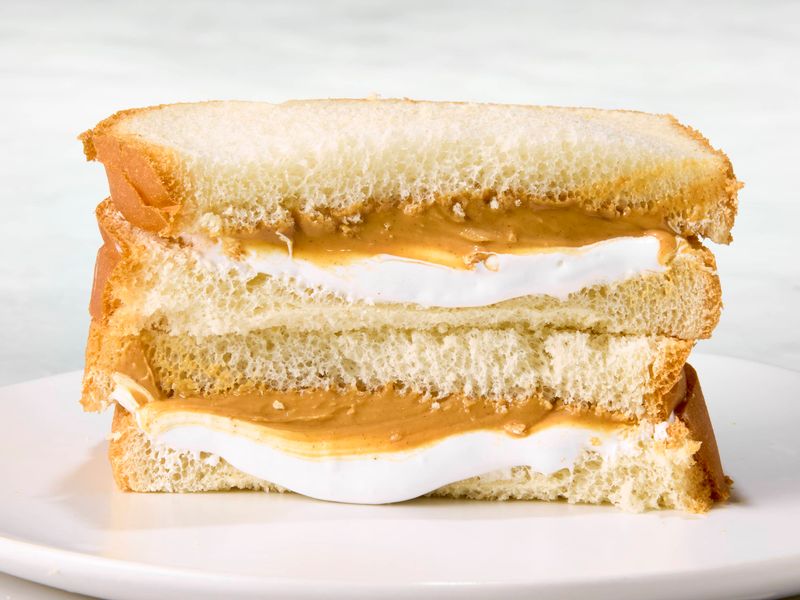
Sugar-loving New England kids once celebrated finding this marshmallow and peanut butter creation in their lunch boxes. The combination of sticky-sweet marshmallow fluff and creamy peanut butter created a dessert-like sandwich that sent children into brief sugar frenzies.
Assembly required careful spreading to prevent the marshmallow from squishing out the sides. The resulting sandwich was a gooey, messy affair that left fingers sticky and white bread compressed into a dense sugar delivery system.
Though occasionally enjoyed as a nostalgic treat, this nutritionally questionable sandwich has largely disappeared from regular lunch rotations as parents became more nutrition-conscious.
16. Monte Cristo Sandwich
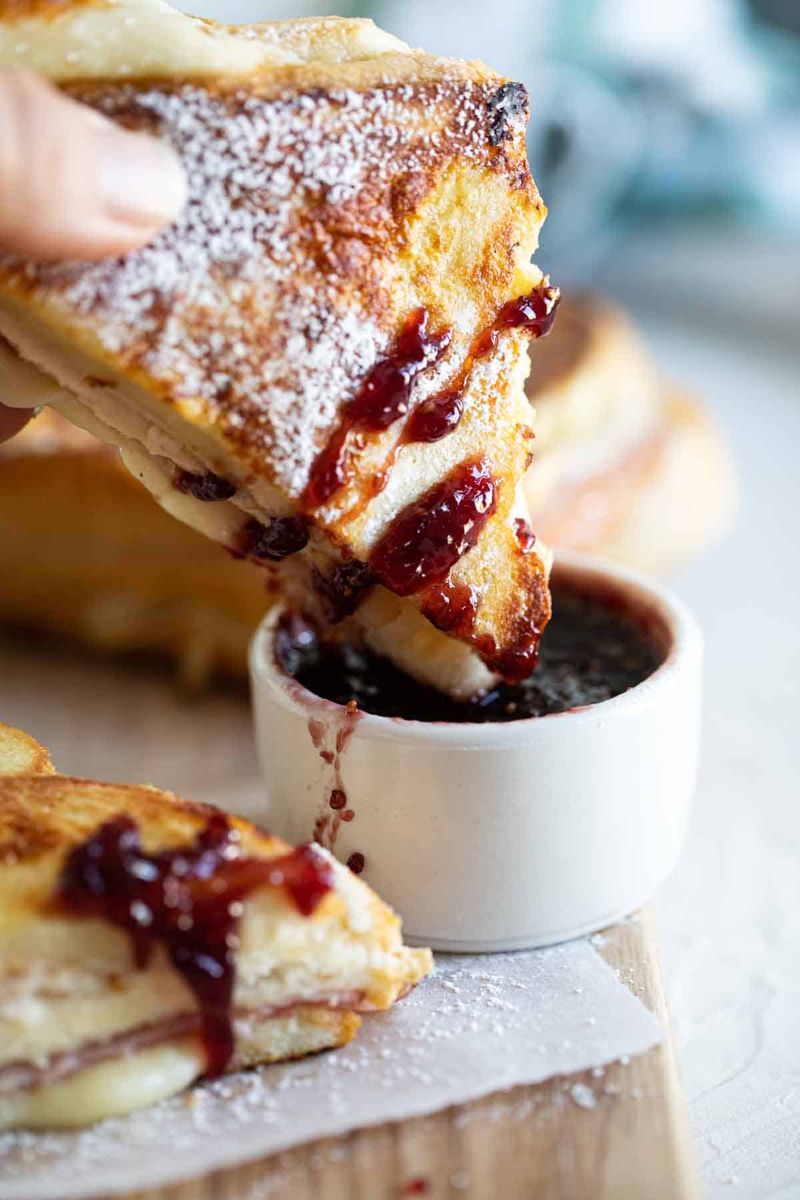
French toast meets ham and cheese in this indulgent creation that dominated diner menus throughout the 1970s. Slices of ham, turkey, and Swiss cheese were stacked between bread, dipped in egg batter, then deep-fried to golden perfection and dusted with powdered sugar.
The Monte Cristo arrived at tables hot and crispy, accompanied by a small ramekin of raspberry jam for dipping. This sweet-savory combination confused first-timers but quickly created devoted fans.
Health concerns eventually pushed this calorie bomb to the margins of American menus, though some retro diners still offer it as an occasional special for those willing to splurge.
1. Pimento Cheese Sandwich
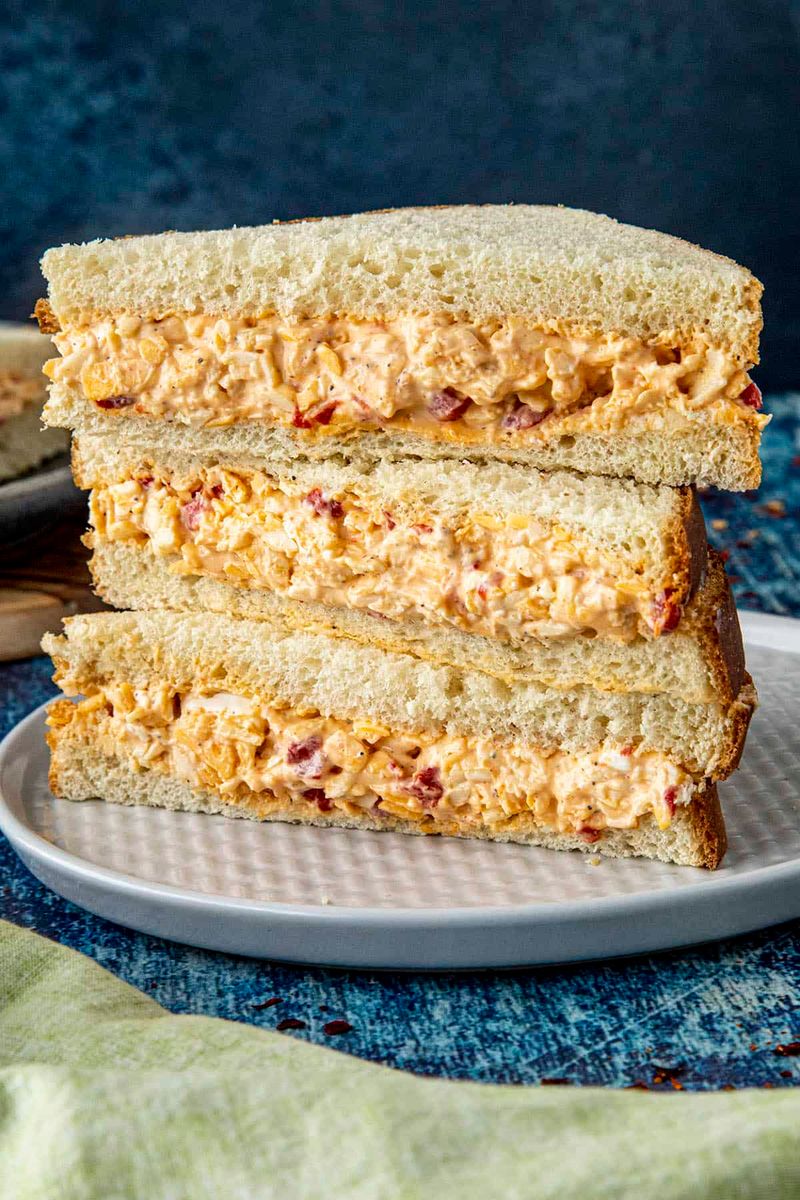
The “caviar of the South” deserves its current culinary renaissance. This vibrant spread combines sharp cheddar, diced pimentos, and creamy mayonnaise into a distinctively orange mixture that transforms ordinary bread into something special.
Southern grandmothers guarded their recipes carefully, debating the merits of hand-grating versus food processors and the proper ratio of mayo to cheese. Some added secret ingredients like cream cheese for smoothness or a dash of hot sauce for kick.
Perfect for summer picnics or elegant tea parties when served on crustless white bread, this versatile spread works equally well melted on burgers or stuffed into celery sticks.
2. French Dip Sandwich
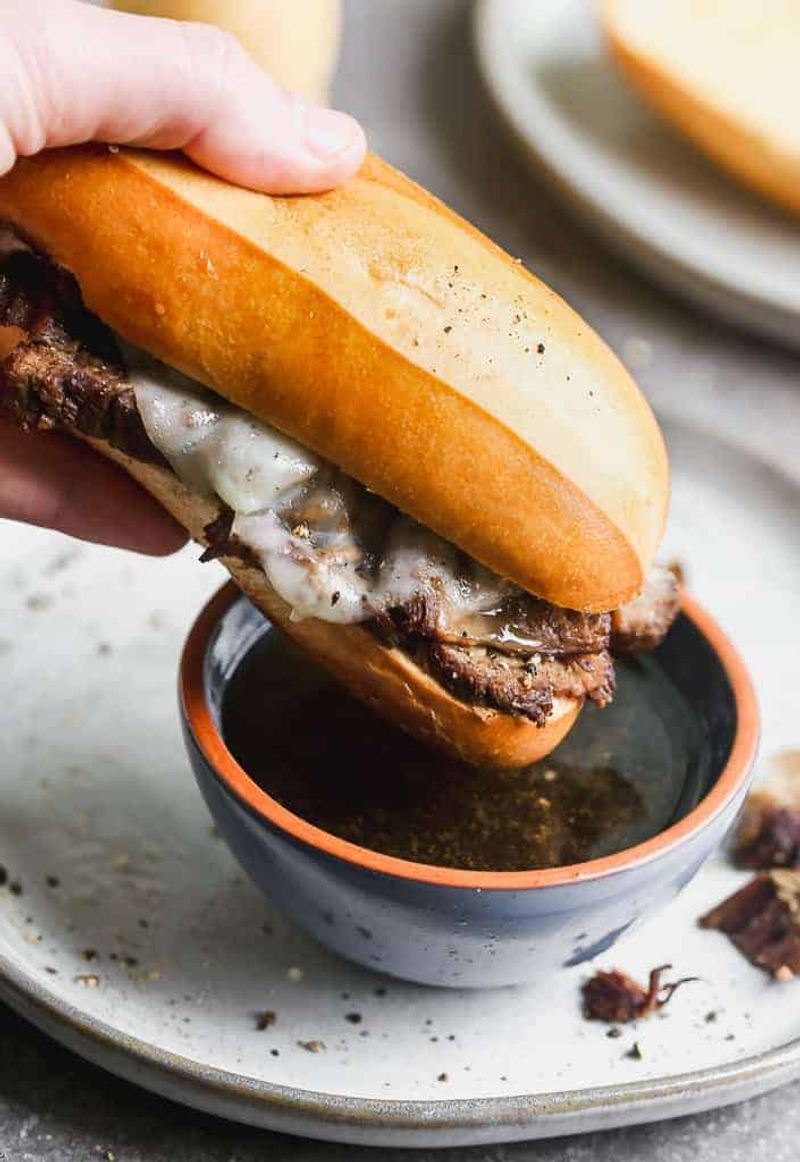
Elegance meets simplicity in this classic that features thinly sliced roast beef on a crusty baguette, served alongside a small bowl of rich, warm au jus. The magic happens when you dip each bite into the savory beef broth, transforming dry bread into a flavor-soaked delight.
Two Los Angeles restaurants still battle over who invented this masterpiece in the early 1900s. The original versions featured simple roast beef and jus, though modern interpretations sometimes add caramelized onions or melted cheese.
Perfect for lunch or dinner, this satisfying sandwich deserves regular rotation on modern menus for its brilliant combination of textures and flavors.
3. Tuna Melt Sandwich
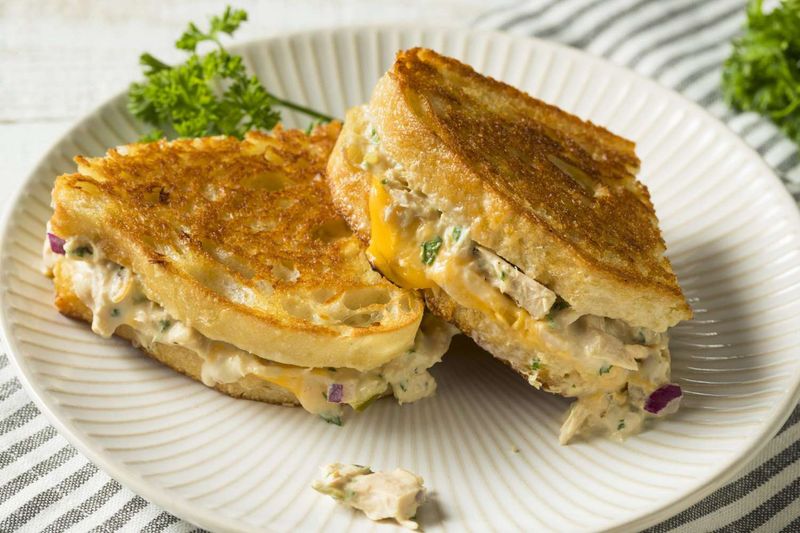
Comfort food perfection exists in this hot sandwich that pairs creamy tuna salad with melted cheese. The contrast between the warm, gooey top and the cool tuna mixture creates a textural masterpiece that deserves permanent menu status.
The best versions start with quality tuna mixed with just enough mayonnaise, diced celery for crunch, and perhaps a touch of lemon juice for brightness. Topped with cheddar or Swiss cheese and grilled until golden, the sandwich develops a crispy exterior that yields to the soft filling.
Whether served open-faced or as a traditional sandwich, this affordable protein-packed meal deserves recognition beyond the diner counter.
4. Club Sandwich
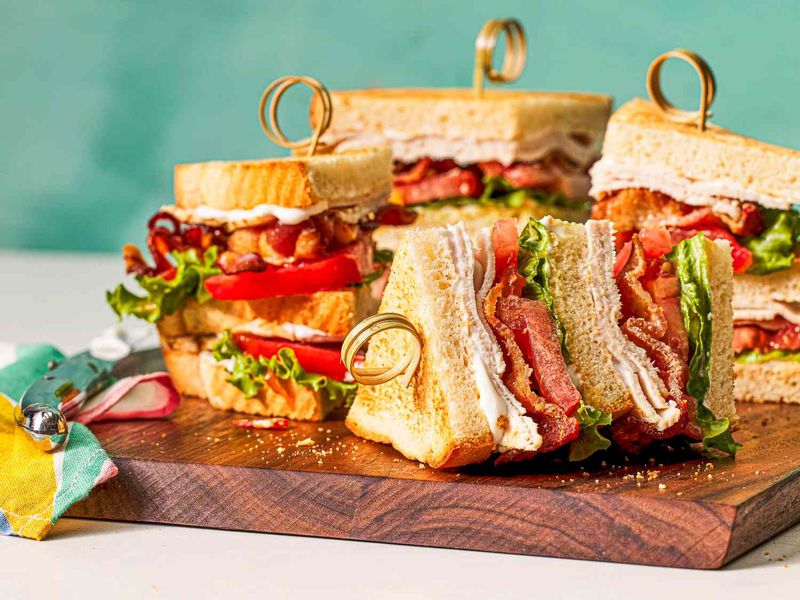
Architectural marvel meets flavor harmony in this triple-decker creation that layers turkey, bacon, lettuce, tomato, and mayonnaise between three slices of toasted bread. Those signature frilly toothpicks holding each quarter together aren’t just decorative—they’re structural necessities for this towering sandwich.
Originating in exclusive men’s clubs in the late 1800s, this sandwich has always signaled a certain refinement. The contrasting textures of crisp bacon, juicy tomato, and cool lettuce create a symphony of flavors in each carefully constructed bite.
Despite its somewhat fussy construction, this classic deserves resurrection for its perfect balance of ingredients and impressive presentation.
5. Patty Melt Sandwich
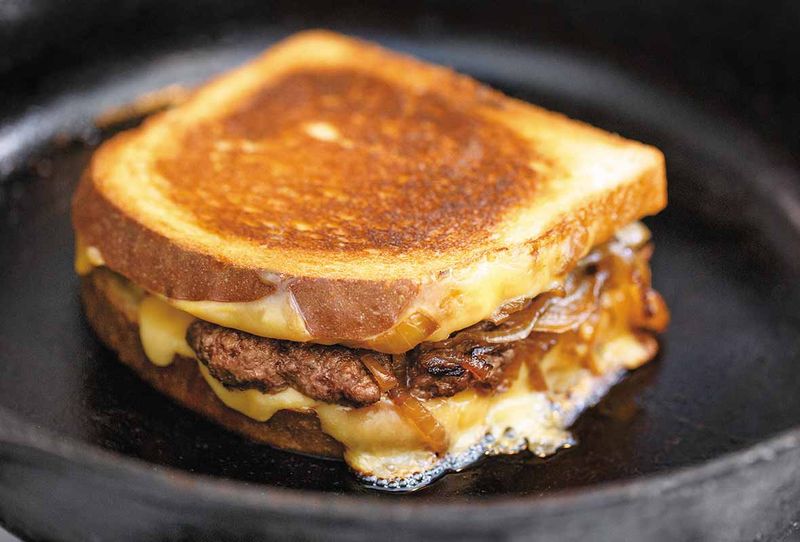
Not quite a burger, not quite a grilled cheese—the patty melt exists in delicious limbo between American classics. A thin beef patty nestles between slices of grilled rye bread with melted Swiss cheese and sweet caramelized onions, creating a harmonious blend that transcends its simple ingredients.
The key lies in the cooking method: the assembled sandwich must be grilled with butter until the bread turns golden-crisp and the cheese reaches the perfect molten state. A light spread of Russian dressing or mayonnaise adds moisture and tang.
This diner staple deserves revival for its perfect union of comfort food elements.
6. Fried Bologna Sandwich
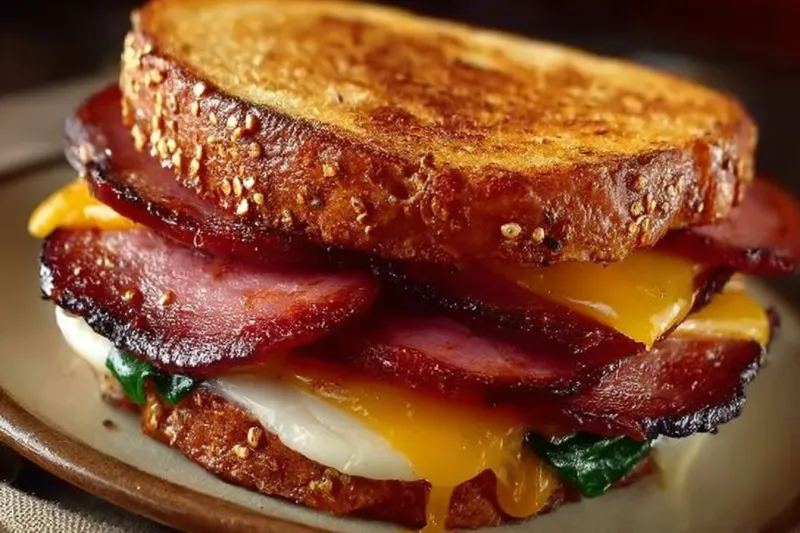
Working-class nostalgia comes packaged in this humble sandwich that features a slice of bologna fried until the edges curl up, creating a little meat “cup” that collects flavor. The hot, slightly crispy meat gets nestled between slices of white bread with yellow mustard and maybe a slice of American cheese.
Depression-era families stretched their meat budget with this affordable option. The simple act of frying transforms ordinary cold cuts into something special, with the heat releasing the bologna’s savory notes.
Unpretentious and satisfying, this sandwich deserves reconsideration as a quick, comforting meal that connects generations through shared food memories.
7. Muffuletta Sandwich

New Orleans gave America this magnificent creation featuring layers of Italian meats and cheese topped with tangy olive salad on a round Sicilian sesame bread. The sandwich originated with Italian immigrants who packed these hearty meals for dockworkers.
The magic lies in the olive salad—a mixture of chopped olives, pickled vegetables, capers, and herbs marinated in olive oil. This mixture seeps into the bread, flavoring every bite with briny goodness.
Traditional muffulettas are served at room temperature after the ingredients have had time to meld together. This engineering marvel of a sandwich deserves wider appreciation for its complex flavors and satisfying heft.
8. Chivito Sandwich

Uruguay’s national sandwich makes most American creations look timid by comparison. This magnificent tower begins with a thin steak and then piles on mozzarella, ham, bacon, lettuce, tomato, olives, hard-boiled eggs, and mayonnaise between crusty bread rolls.
Legend claims the sandwich was created when a customer requested goat meat (“chivito” in Spanish), and the chef, having none, substituted this elaborate creation instead. The combination of protein sources creates an unforgettable flavor experience that somehow works despite its complexity.
Though challenging to eat neatly, this international treasure deserves recognition for its bold approach to sandwich architecture and flavor layering.
Leave a comment